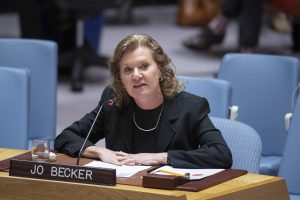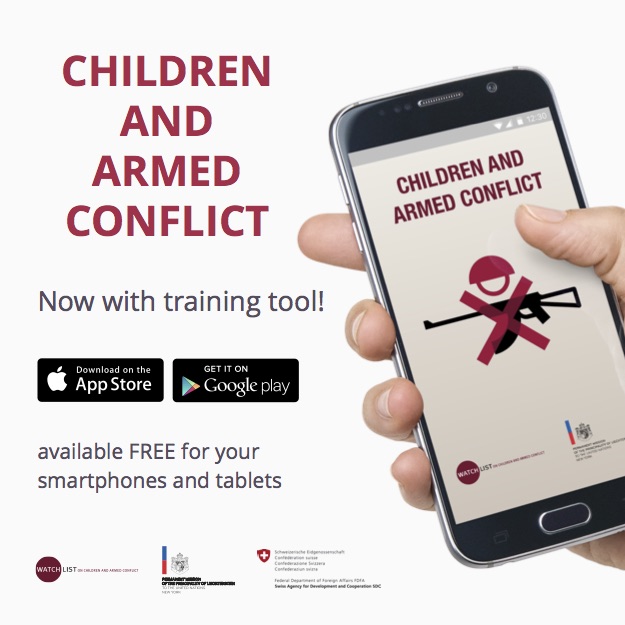On February 12, 2020, Belgium, in its capacity as President of the UN Security Council, convened a Council briefing on children and armed conflict, entitled “Integrating child protection into peace processes to resolve conflict and sustain peace.” Ms. Jo Becker was invited to provide a briefing in her capacity as chair of the Advisory Board of Watchlist on Children and Armed Conflict. The statement follows:

UN Photo/Eskinder Debebe.
Mr. President, Your Highness, Excellencies, Ladies and Gentlemen:
I’m honored to address you today on behalf of the Watchlist of Children and Armed Conflict, a global network of human rights and humanitarian organizations devoted to protecting and promoting the rights of children in armed conflict.
In 1996, when Graca Machel presented her seminal study on the Impact of Armed Conflict on Children, she deplored that until that time, no peace treaty had formally recognized the existence of child combatants. Without this recognition, she said, there could be no effective planning for peace.
Since then, the Security Council has repeatedly called for the inclusion of child protection in peace processes. But in reality, peace agreements that address child protection are still rare. They are the exception, not the norm.
The Watchlist on Children and Armed Conflict conducted an analysis of ceasefire and peace agreements to assess how well they address child protection. We were pretty discouraged by the results. We looked at all documents in the Department of Political Affairs Peace Agreements Database, going back to 1999, when the Security Council first took up children and armed conflict. The documents included peace and ceasefire agreements, as well as declarations and other communiques.
Of 445 documents, fewer than 18 percent included child protection provisions. And many of the documents that did reference children did so only in the most general way – for example, by calling for the “protection of women, children, and other vulnerable groups.”
This simply isn’t good enough.
We know that children suffer disproportionately more in war. They also benefit less in peace.
Peace processes and agreements do more than end war. They establish a framework for transition, and the political, social, and economic agenda for peace. They establish priorities for post-conflict investment and resource allocation. When children are excluded from peace agreements, their needs and rights become invisible. The result is under-investment and lack of critical programming. In such circumstances, we can’t be surprised if new grievances emerge and former child soldiers take up arms again.
Addressing the needs of conflict-affected children in peace processes isn’t just a legal or moral imperative – it’s crucial to a durable peace.
Our experiences with peace processes to date highlight some critical gaps:
- Peace agreements are most likely to address the issue of child soldiers, but they often fail to address justice for child soldiers as victims or accountability for the leaders who have recruited children. This failure has contributed to impunity and continued cycles of recruitment and re-recruitment, in conflicts such as the Democratic Republic of Congo, for example.
- Provisions on children associated with armed forces or groups are often too narrow, focused only on child combatants, and failing to include girls, or those who did not bear arms. In Liberia, for example, community groups needed to advocate after the signing of the 2003 peace agreement to ensure that DDR efforts included all affected children.
- Despite years of attention to the issue, some peace agreements still fail to address child soldiers at all. The 2015 Bamako agreement for Mali, for example, does not mention the issue or include children in DDR provisions, despite high level advocacy by the SRSG on children and armed conflict.
- Peace processes and related accountability mechanisms often fail to include channels for child participation. In South Africa, for example, the Truth and Reconciliation Commission found that few children approached to tell their stories until they convened special hearings on children and youth. Once organized, these hearings drew enormous input. In Libya, over 75 public consultations were held in 2018, involving over 7,000 Libyans. Special consultations were held for women, university students, and the displaced, but none were specifically designed to include children. This was a real missed opportunity.
- Institution-building often ignores children. Guatemala’s peace agreement, for example, included important provisions to strengthen the justice system for adults, resulting in funding, training, and monitoring. But justice systems for children were never even considered at the negotiating table and received no resources.
Some take the view that general provisions to benefit the population at large will automatically trickle down and benefit children. Our experience is that this is not the case. We’ve learned that specificity is essential.
We also have some good examples to learn from:
- One of the first peace agreements to address children was the 1999 Lome peace accord for Sierra Leone. It called for particular attention to child soldiers, including the mobilization of resources, and their inclusion in the DDR process. This paved the way for the formal demobilization of nearly 7,000 children. Later studies found that the response in Sierra Leone was far more effective and integrated than in many other conflicts, and that children who were demobilized appeared to be doing as well as other children in their communities.
- Colombia provides a particularly good model, where an explicit agreement on release of children under 15 by the FARC-EP helped build trust between the parties ahead of the final agreement. The peace agreement itself has some of the most comprehensive provisions for children. Children are referenced dozens of times, with detailed provisions regarding health, early childhood education, food security including school feeding programs, and a truth, justice and reparations system mandated to pay specific attention to crimes against children.
- Some peace agreements have included specific protections for schools, which are often targeted during conflict or used for military purposes. For example, the 2002 ceasefire agreement between Sri Lanka and the Liberation Tigers of Tamil Eelam, stipulated that within 160 days, school buildings occupied by either party would be vacated and returned to their intended use.
In 2016, based on broad consultations and analysis, Watchlist prepared a checklist for provisions related to children and armed conflict in ceasefire and peace agreements, which inspired the UN and member states to develop the more detailed guidance being launched today. Some of the key components we identified include the following:
- Prioritizing child protection in the agenda of the peace talks from the very beginning;
- Ensuring that that all parties explicitly agree to end the six grave violations against children, including by naming them as specific violations of ceasefire agreements;
- Including specific provisions for children associated with armed forces or groups, including adequate resource mobilization and inclusion in DDR processes, while also recognizing that children should be released and reintegrated at all times;
- Addressing protections for education, including agreements by parties to vacate and rehabilitate schools that have been used for military purposes;
- Ensuring that children’s needs and rights are adequately addressed and resourced in post-conflict programming, including their physical and mental health needs, education, and vocational and economic opportunities;
- Ensuring that transitional justice, accountability, and reparations mechanisms specifically address violations against children and solicit children’s views;
- Ensuring that monitoring and implementation mechanisms for peace agreements address all child protection provisions, including the six grave violations, and provide for civil society participation to promote transparency and accountability.
We welcome the new Guidance for mediators to protect children in situations of armed conflict, and strongly urge the Secretary-General to ensure its broad dissemination in the UN system.
The UN Security Council can also help ensure child protection in peace processes. We urge the Security Council to take the following steps:
- Request that all conflict analyses include a specific assessment of the impact of conflict on children to ensure that these issues are dealt with at the beginning of any peace effort;
- Ensure that country-specific statements and resolutions regarding peace processes emphasize the need for explicit and comprehensive provisions for child protection;
- Urge mediators, the United Nations, parties to conflict and other stakeholders to ensure the meaningful participation of affected children in peace processes and that their views are taken into account;
- Ensure dedicated and adequately resourced child protection capacity in UN peace operations and political missions;
- Request the Secretary-General and UN Special Envoys to ensure that all reports on peace processes and the monitoring and implementation of peace agreements specifically address child protection issues;
- As a foundation for accountability, insist that the Secretary-Generals’ annual list of perpetrators of violations against children is accurate and evidence-based, utilizing the data collected by the monitoring and reporting mechanism on children and armed conflict.
We appreciate the Security Council’s attention to this important issue.
Thank you for your attention.



